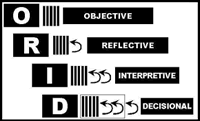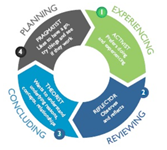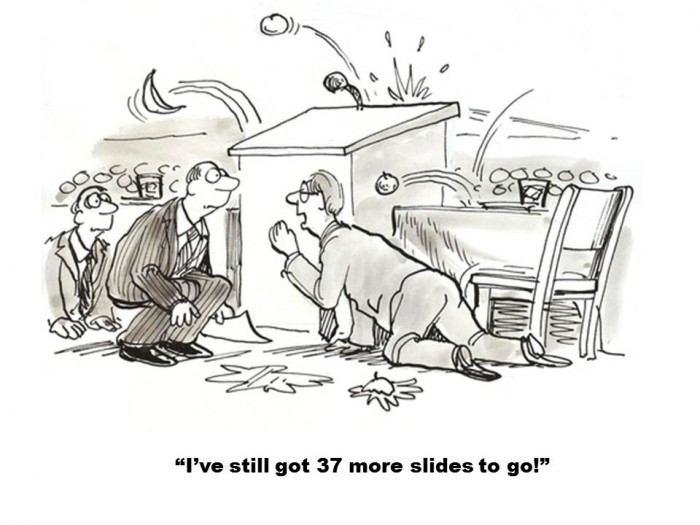Presenting well requires a set of skills and as such can be learned and continuously improved. This article provides key tips for designing and delivering effective presentations. It is designed to assist you with planning for and delivering presentations.
Preparing for success

Firstly, set clear objectives or learning outcomes for the audience you are presenting to. This will give a clear focus when developing your presentation.
Next, know your audience. Answer these sort of questions: Who are they, what characteristics do they have, what are their needs and why would they want to hear you present? What do you and your presentation have to offer them? The key is to be clear on “What’s in it for them”
Lastly, where are you presenting and at what time of day? Plan for the environment you will be in and what influence both the environment and time of day may have on the energy levels and mood of the audience.
Suggested flow for your presentation
The ORID method (Objective, Reflective, Interpretive and Decisional) is a good way to structure a presentation and helps your audience to focus and think through what you are presenting. Importantly, it can assist them through an experiential learning process and draw conclusions from the presentation that are relevant to themselves. It follows a natural human process for communication.

Image source: The Institute of Cultural Affairs
The ORID method was developed by Laura Spencer of the Institute of Cultural Affairs (USA) and is based on the Kolb Experiential Learning Model (Kolb, 1984). Laura Spencer is the author of the book Winning Through Participation (1989), which details the ORID method. The method was further developed by Brian Stanfield in his book, The Art of Focussed Conversation (2000).

The key to using it effectively is to have your audience ask questions of themselves at each key stage of your presentation.
Designing your presentation to follow the ORID method
Objective – Provide the context. Set the scene. Introduce the objective of the presentation or paper. Establish the facts and introduce any data sources that are behind your presentation. Provide the basis to get all of the audience “on the same page”.
Reflective – Help participants to identify or context their own situation to the subject, objectives or learning outcomes you have for the presentation. Providing key questions, analogies, practical examples or benchmarks are useful. It is also useful to help participants think about how they are feel about the subject area.
Interpretive – Provide information that helps participants to learn about the subject and identify what is important to them in respect to it. Help the participants think more deeply about the subject.
Decisional – Draw conclusions and help participants identify future actions they make take as a result of your presentation.
As the ORID process is based on the experiential learning model, the suggested elements to check your presentation against are:
Review/Reflect – Are the participants able to identify their current level of ability in respect to the key learning outcome(s) and are the participants able to identify the importance of the key learning outcomes to themselves and their own circumstances? Can you identify how they are reacting to your presentation? How do they feel about the points you are making?
Context/Interpret/Make sense of – Can the participants context the information you provide against their own personal situation?
Plan – Can the participants identify what it is important that they now do in relation to the objectives/learning outcomes you set for the presentation?
Act – As a result of the presentation, can the participants now carry out actions that will assist them in achieving the learning outcomes set for the presentation?
Catering for participant learning styles

Each participant will have preferred ways to learn. Catering for different learning styles in your presentation design will help it be more effective for the audience as a whole. This is done by including a range of styles of presentation that will appeal to different learning styles in your approach. The suggestion is to audit your presentation against the Peter Honey and Alan Mumford Learning Styles.
Activitist – What can participants do or participate in as part of the presentation?
Pragmatist – What analogies or practical examples can be used? How can it be applied to suit participants own circumstances? What tools or processes can you provide them with that will help?
Theorist – What “expert input”, facts or theory are behind the key learning outcomes?
Reflector – How can participants reflect or review in relation to their own situation and/or the topic and key learning outcomes?
Tips when presenting
Don’t use just the one presentation approach.

Pay attention to details – stick to time. Dress to suit the audience. Arrive early and ensure any audio-visual equipment is set up and ready to suit your presentation. When you arrive assess the location you are to present in and adapt your delivery style accordingly, particularly if their are unforeseen circumstances.
At the start of the presentation, establish the “right to speak”. For some presentations, this may be done by a Chairperson who introduces you. If not, do it as you introduce yourself (but don’t overdo it).
Have a strong opening and closing – To open strongly use high energy and animation. Use a key opening point, thought provoking slide, statistic, key question or example. Help the audience identify a need of theirs you will be able to address; illustrate a problem or an opportunity as an example and show how the presentation may help to address them. Get them to do something: Raise their hands, stand, do a quick practical exercise; challenge them with a thought provoking question. Give a thought provoking analogy or a key example from your own experience; tell a short story. Ensure you give them an outline of your presentation through which they can quickly identify “what’s in it for them”.
Use a conversational style when presenting, try not to read off notes; but rather use dot point prompts if you need to keep yourself on track. Engage with the audience by using some names in the audience as you present. Move around the area you are presenting in. Rove around the room with your eye contact, look for friendly faces and acknowledge interactions from the audience.
Put some energy spikes into your presentation at key intervals. Ask the audience questions or to carry out short activities that will help illustrate your key points. Use some props, tell a joke, show a short video; really do anything that will grasp their attention and lift their energy and focus at key points in your presentation, is what you are after.
Have one key point and no more than three of four key messages for your presentation, for each 30 minutes of presentation time. These should all relate to “what’s in it for them”. Refer to them three or four times during your presentation and as part of opening and closing.
Close strongly, reiterating your key point(s) and help the audience identify what they can do individually as a result of your presentation. Provide any links or addresses for contact and for further information.
Some tips to dealing with anxiety when presenting
It is widely reported that fear of public speaking effects 75% of the population and is often their greatest fear. Like many fears, experience or repetition/desensitising, works over time; but what can be done in the short term to help manage the fear? The main thing is to recognise that you are anxious or going to be and plan some strategies to help manage the fear, jot them down and follow them. Use the following tips as a guide:
- Know your topic well.
- Memorise your opening lines, so you can get started easily.
- Rehearse with colleagues, friends or family.
- Make sure you get as normal a sleep as possible the night before.
- Know your audience. Engage with people you know as you arrive and when you present.
- Exercise the morning of your presentation and immediately before you present; exercise helps prepare your body to deal with a stressful situation.
- Eliminate caffeine and sugary foods before you present and eat more dairy, protein and complex carbohydrates. Eat two hours beforehand.
- Go to the bathroom immediately beforehand.
- Make sure you have a glass of water with you when you go to present.
- Get there early and be prepared.
- Remember the audience is on your side, they want you to do well.
- Build in breaks for yourself; ask a question, play a video, take a poll. This gives you a chance to breathe and relax.
- Ground yourself by holding the podium or the back of a chair periodically.
- Move and use gestures.
- Regulate your voice: Change your tone. Slow down. Use animation.
- Look at friendly faces or people you know in the audience.
- Practice – look for opportunities over time to present and each time it will get easier.
Content sources and further information
Winning through participation : Meeting the challenge of corporate change with the Technology of participation. Laura J. Spencer (1989). Kendall/Hunt Pub. Co. ISBN 0840361963 (pbk.) 0840353731
The Art of Focused Conversation. Brian Stanfield (2000). Co-published by The Canadian Institute of Cultural Affairs and New Society Publishers. ISBN: 9780865714168
